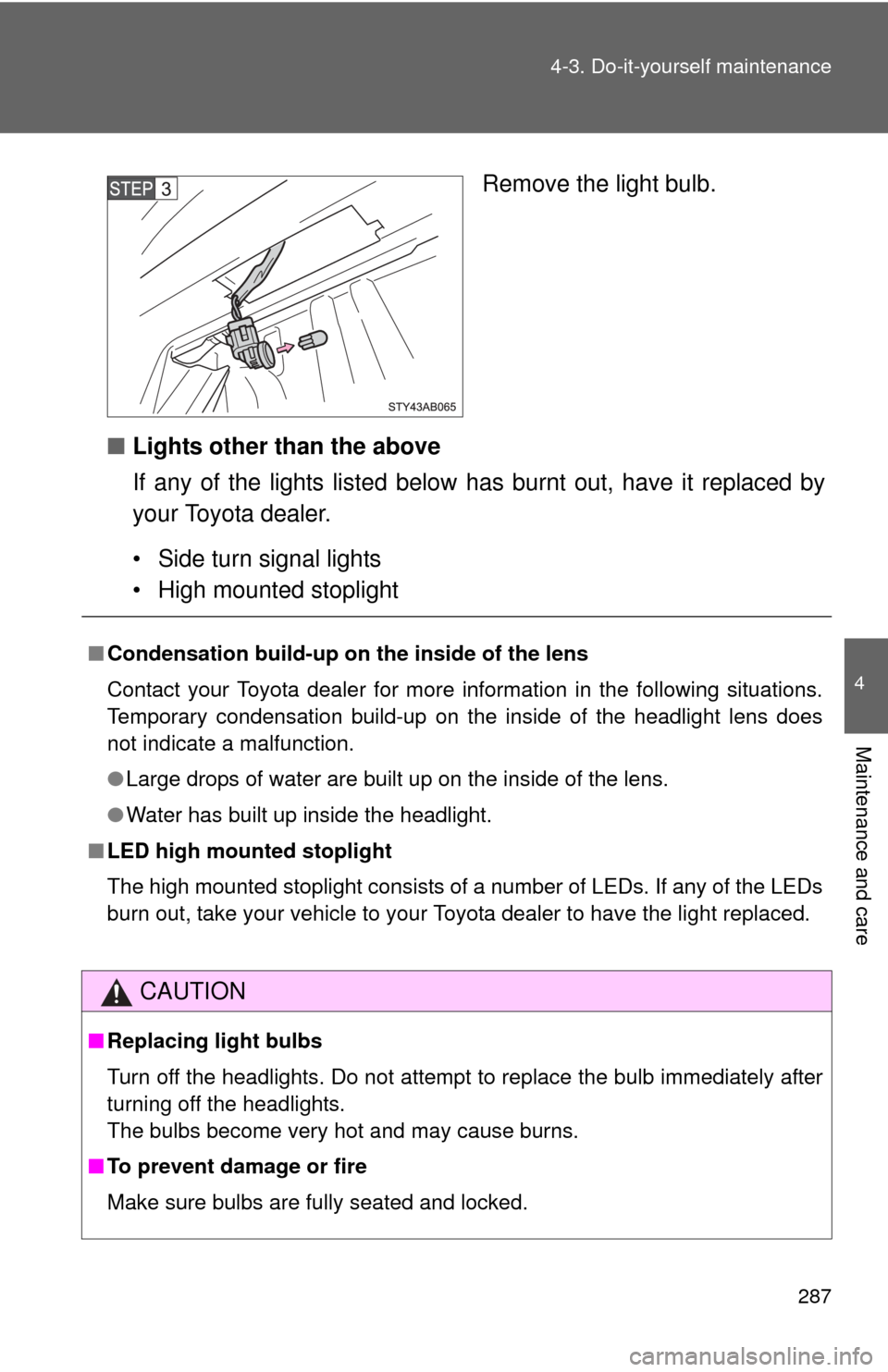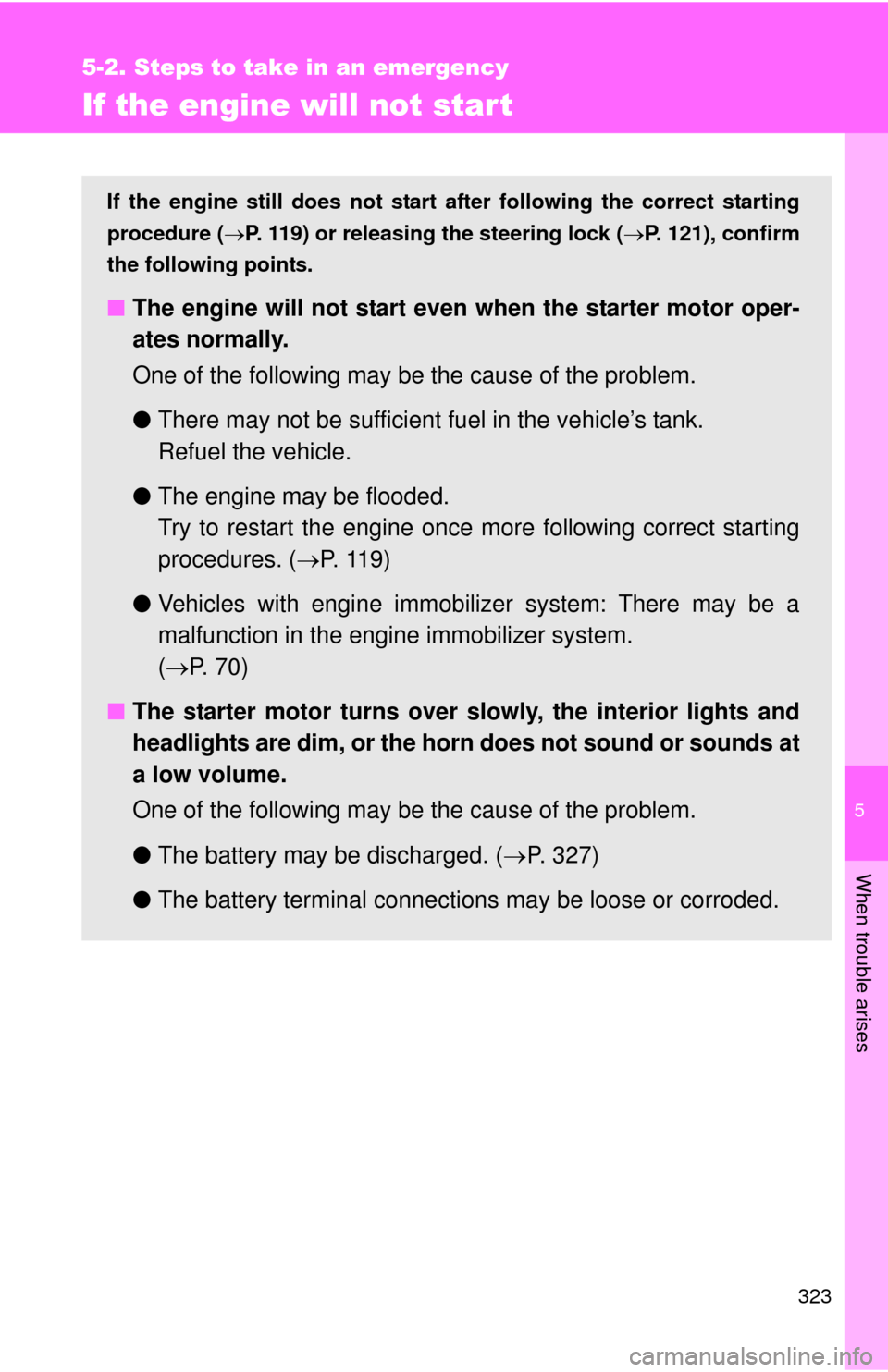Page 280 of 388
280
4-3. Do-it-yourself maintenance
Light bulbs
You may replace the following bulbs yourself. The difficulty level of
replacement varies depending on the bulb. If necessary bulb
replacement seems difficult to perfor m, contact your Toyota dealer.
For more information about replacing other light bulbs, contact your
Toyota dealer.
■ Prepare a replacement light bulb.
Check the wattage of the light bulb being replaced. ( P. 346)
■ Front bulb locations
Headlights
Front fog lights
(if equipped)
Front side marker lights
Front turn signal lights
Parking lights
Page 281 of 388
281
4-3. Do-it-yourself maintenance
4
Maintenance and care
Replacing light bulbs
■ Headlights
Unplug the connector.
Remove the rubber cover.
■Rear bulb locations
Back-up lights
Rear turn signal lights Stop/tail and rear
side marker lights
License
plate light
Page 287 of 388

287
4-3. Do-it-yourself maintenance
4
Maintenance and care
Remove the light bulb.
■ Lights other than the above
If any of the lights listed below has burnt out, have it replaced by
your Toyota dealer.
• Side turn signal lights
• High mounted stoplight
■ Condensation build-up on th e inside of the lens
Contact your Toyota dealer for more information in the following situations.
Temporary condensation build-up on the inside of the headlight lens does
not indicate a malfunction.
● Large drops of water are built up on the inside of the lens.
● Water has built up inside the headlight.
■ LED high mounted stoplight
The high mounted stoplight consists of a number of LEDs. If any of the LEDs
burn out, take your vehicle to your Toyota dealer to have the light replaced.
CAUTION
■Replacing light bulbs
Turn off the headlights. Do not attempt to replace the bulb immediately after
turning off the headlights.
The bulbs become very hot and may cause burns.
■ To prevent damage or fire
Make sure bulbs are fully seated and locked.
Page 288 of 388
288 4-3. Do-it-yourself maintenance
NOTICE
●Halogen bulbs have pressurized gas inside and require special handling. \
Do
not touch the glass portion of the light bulb with bare hands. Hold the bulb by
the plastic or metal portion.
If the bulb is scratched or dropped it may blow out or crack.
● Fully install light bulbs and any parts used to secure them. Failing to do so
may result in heat damage, fire, or water entering the headlight unit. This
may damage the headlights or cause condensation to build up on the lens.
Page 323 of 388

5
When trouble arises
323
5-2. Steps to take in an emergency
If the engine will not star t
If the engine still does not start after following the correct starting
procedure ( P. 119) or releasing the steering lock ( P. 121), confirm
the following points.
■ The engine will not start even when the starter motor oper-
ates normally.
One of the following may be the cause of the problem.
●There may not be sufficient fuel in the vehicle’s tank.
Refuel the vehicle.
● The engine may be flooded.
Try to restart the engine once more following correct starting
procedures. ( P. 1 1 9 )
● Vehicles with engine immobilizer system: There may be a
malfunction in the engine immobilizer system.
( P. 7 0 )
■ The starter motor turns over slowly, the interior lights and
headlights are dim, or the horn does not sound or sounds at
a low volume.
One of the following may be the cause of the problem.
●The battery may be discharged. ( P. 327)
● The battery terminal connec tions may be loose or corroded.
Page 324 of 388
324 5-2. Steps to take in an emergency
■The starter motor does not turn over, the interior lights and
headlights do not turn on, or the horn does not sound.
One of the following may be the cause of the problem.
● One or both of the battery terminals may be disconnected.
● The battery may be discharged. ( P. 327)
Contact your Toyota dealer if the problem cannot be repaired, or if
repair procedures are unknown.
Page 329 of 388
5
When trouble arises
329
5-2. Steps to take in an emergency
■
Avoiding a discharged battery
●Turn off the headlights and the audio system while the engine is turned
off.
● Turn off any unnecessary electrical components when the vehicle is run-
ning at a low speed for an extended period, such as in heavy traffic, etc.
Start the engine of the second vehicle. Increase the engine
speed slightly and maintain at that level for approximately 5
minutes to recharge the battery of your vehicle.
Maintain the engine speed of the second vehicle and start
the vehicle's engine.
Once the vehicle’s engine has started, remove the jumper
cables in the exact reverse order in which they were con-
nected.
If removed, replace all the battery vent plugs.
Reinstall the cover.
Once the engine starts, have the vehicle checked at your Toyota
dealer as soon as possible.
Page 346 of 388
346 6-1. Specifications
Light bulbs
A: HB2 halogen bulbs
B: H11 halogen bulbs
C: Single end bulbs
D: Single end bulbs (amber)
E: Wedge base bulbs
F: Wedge base bulbs (amber)
G: Double end bulbs
Light BulbsBulb NoWTy p e
ExteriorHeadlights — 60/55 A
Parking lights
—5E
Front fog lights
(if equipped) —55 B
Front side marker
lights —5 E
Front turn signal lights — 21 D
Side turn signal lights — 5F
Rear turn signal lights — 21 D
Stop/tail and rear side
marker lights — 21/5 E
Back-up lights — 21C
License plate light — 5E
Interior Interior light — 8 G
Personal lights
—8E
Luggage compart-
ment light —5 G